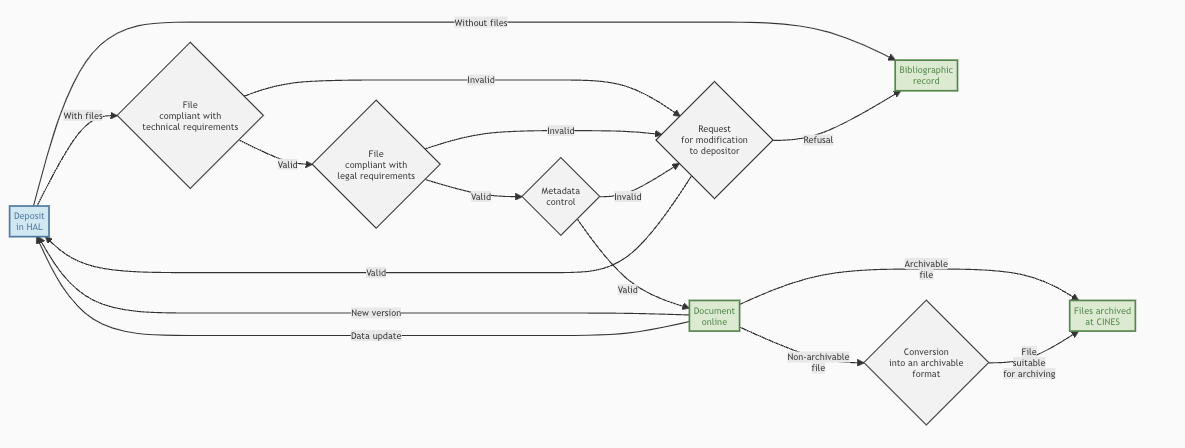Deposit
HAL is open to researchers from academic institutions in France and abroad who wish to share their research results, whether they have been published or not.

Deposit¶
Documents are self-archived or deposited by third parties such as librarians. The user must create an account to deposit.
Once authenticated, the user can deposit via the user interface (Upload) or via API (SWORD protocol).
The user can:
- upload one or more files per deposit,
- add new version(s),
- add supplementary files,
- create a bibliographic reference only,
- complete a bibliographic reference with one or more files (fulltext and/or supplementary materials).
The user must check and accept the following conditions to save the deposit:
- He/She authorizes HAL to put the publication online and distribute it;,
- He/She is aware that deposits cannot be deleted once accepted;,
- He/She understands that HAL reserves the right to reclassify or reject all deposits.
Metadata¶
The submission form includes a set of descriptive metadata that vary according to the type of document selected, some of which are mandatory.
It makes it possible to
- identify the author(s),
- identify their affiliation,
- give the bibliographical description of the publication (title, journal title for an article, publication date, pagination, etc.)
- provide the link to research data archived in repositories,
- Identify the source of funding,
- improve interoperability with other repositories and platforms (see also the list of identifiers used in HAL).
At least one affiliation is mandatory in the deposit. For ease of use, the affiliation can be added in the user's profile. Affiliation metadata is used to automatically populate institutional portals and laboratory collections.
The depositor undertakes to provide accurate information.
Checking the files before they are put online¶
All deposits with a file are manually checked before they are put online: creation of a new deposit, addition of a new version or supplementary material. This step ensures that the files and metadata describing them, freely accessible on the internet, are usable by any user. The user must indeed be able to open and /or download the file, read the full text of the document, use it in the respect of intellectual property and have accurate bibliographic information.
The CCSD team and the teams in charge of the institutional portals carry out this verification. Depending on the number of deposits that need to be processed, it may take a few days to bring them online.
Licenses¶
Each deposit should contain a clear and accessible usage licence in order to be fully reusable according to the FAIR principles. The License metadata therefore allows the author to specify the distribution conditions for his/her document and/or files if the deposit contains several of them. License metadata is mandatory for software, images, maps, video and audio.
HAL is part of the international framework in favour of full and immediate free access to scientific publications and preferably recommends the use of licences, as the Creative Commons. It also recommends the choice of the CC-BY licence for documents whose distribution is not already regulated by a publishing contract.
Metadata are under a CC-0 license.
Citations¶
The bibliographic citation of documents is generated from the metadata.
It is displayed for consultation in the “Cite” block.
Example of citation : Dominique Daudon, Yannick Sieffert, Osvaldo Albarracin, Lucas Garino Alibardi, Gustavo Navarta. Adobe Construction Modeling by Discrete Element Method: First Methodological Steps. Procedia Economics and Finance, 2014, 4th International Conference on Building Resilience, 8-11 September 2014, Salford Quays, United Kingdom, 18, pp.247-254. ⟨10.1016/s2212-5671(14)00937-x⟩.⟨hal-02004091⟩